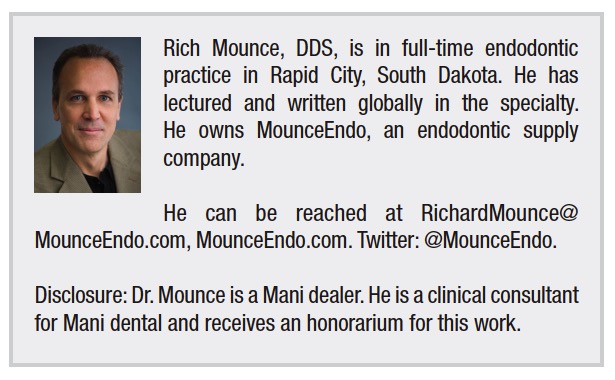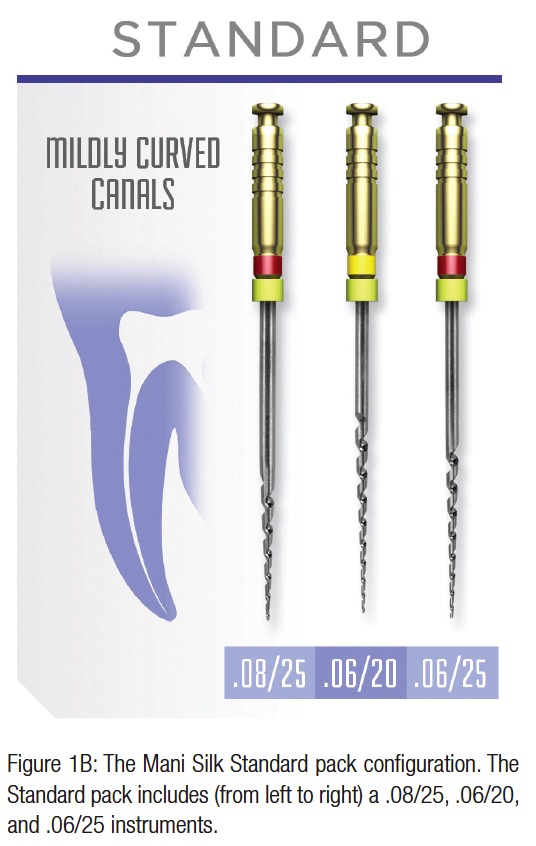Dr. Rich Mounce discusses a new anatomy-based, efficient, safe, and predictable system
 This article was written to describe the clinical use of the new and novel Mani Silk (MS) nickel-titanium instrumentation system, now available in North America. MS is unique and a welcome addition to the endodontic marketplace.
This article was written to describe the clinical use of the new and novel Mani Silk (MS) nickel-titanium instrumentation system, now available in North America. MS is unique and a welcome addition to the endodontic marketplace.
[userloggedin]
MS is:
- Anatomy based. MS is packaged into Simple (relatively straight canals), Standard (moderate curvature, no calcification), and Complex pack configurations (moderate to severe curvature and/or calcification present) to treat the anatomy encountered. Clinically, the tooth is assessed, and the matching MS is chosen to address the given anatomy with a minimum number of files (three total).
- Heat treated from the tip of the file through the first 10 mm of the cutting flutes — providing increased fracture resistance and flexibility where needed.
- “Teardrop”-shaped in cross section. This design channels debris out of the canal efficiently and centers the file (maintaining the canal path) while minimizing transportation. In addition, the teardrop cross-section decreases the “screwing in” effect and simultaneously improves tactile sensation.
- Easily integrated for use with the entire spectrum of Mani stainless hand files.
 Mani Silk system description
Mani Silk system description
MS packs have three files: The Simple pack configuration contains .08/25, .06/25, and .06/30 instruments. The Standard pack contains a .08/25, .06/20, and .06/25 instruments. The Complex pack contains the .08/25, .04/20, and .04/25 instruments. These three canal packs can shape virtually any canal. MS instruments are also available (3 files/pack) in the following individual sizes: .04/20, .04/25, .04/30, .04/35, .04/40, .06/20, .06/25, .06/30, .06/35, .06/40, and .08/25. All pack configurations and individual sizes are available in 21 and 25 mm. Orifice openers are also available in 18 mm lengths. MS is rotated at 500 rpm and 300 g-cm torque. Any torque-controlled endodontic motor can power MS. MS instruments have a constant taper (.08, .06, .04). The file is electropolished for increased fatigue fracture resistance.
Mani Silk clinical technique
After straight-line access and removal of the cervical dental triangle with the MS orifice opener (.08/25), the canal is negotiated and the glide path created. After glide path preparation, MS is utilized as a two-file system (after the use of the orifice opener) that can either be rotated or reciprocated (clockwise).  When using the Simple pack, the .06/25 is followed by the .06/30. When using the Standard pack, the .06/20 is followed by the .06/25. When using the Complex pack, the .04/20 is followed by the .04/25. Specifically, for each of these sequences, the two files listed above are successively alternated until the desired taper is achieved to the true working length. If clinicians wish to prepare a larger apical diameter, they are able to do so using the individual sizes available for this purpose (.04/30, .04/35, .04/40, .06/30, .06/35, .06/40).
When using the Simple pack, the .06/25 is followed by the .06/30. When using the Standard pack, the .06/20 is followed by the .06/25. When using the Complex pack, the .04/20 is followed by the .04/25. Specifically, for each of these sequences, the two files listed above are successively alternated until the desired taper is achieved to the true working length. If clinicians wish to prepare a larger apical diameter, they are able to do so using the individual sizes available for this purpose (.04/30, .04/35, .04/40, .06/30, .06/35, .06/40).
Case study
 In the case illustrated in Figure 2, straight-line access was prepared through the existing initial malgam. The canals were negotiated with Mani K files (Nos. 6, 8, 10, 15, 20) and Mani Medium Files (Nos.12, 17).
In the case illustrated in Figure 2, straight-line access was prepared through the existing initial malgam. The canals were negotiated with Mani K files (Nos. 6, 8, 10, 15, 20) and Mani Medium Files (Nos.12, 17).
 As an aside, where needed, Mani D Finders are an excellent option for negotiation of severely curved and calcified canals as Mani D Finders are much stiffer than standard K files. Both Mani K files and D Finders can be reciprocated by use a reciprocating handpiece like the ER-10 (NSK). Specifically, in the case illustrated, the Mani No. 6 K file was inserted to the apex first, followed by the Nos. 8, 10, 12, 15, 17, 20 Mani hand files and reciprocated with the ER-10 (NSK) to prepare the glide path.
As an aside, where needed, Mani D Finders are an excellent option for negotiation of severely curved and calcified canals as Mani D Finders are much stiffer than standard K files. Both Mani K files and D Finders can be reciprocated by use a reciprocating handpiece like the ER-10 (NSK). Specifically, in the case illustrated, the Mani No. 6 K file was inserted to the apex first, followed by the Nos. 8, 10, 12, 15, 17, 20 Mani hand files and reciprocated with the ER-10 (NSK) to prepare the glide path.
 After glide path preparation, an MS Standard Pack was used to shape this case. The .06/20 and .06/25 were alternated until the .06/25 reached the true working length. The master apical diameter was subsequently prepared with the .06/30. Insertion of MS is gentle, passive and to resistance, taking approximately 3 seconds and shaping approximately 4-6 mm of canal space per insertion. After every insertion of MS, the canal was recapitulated with a No. 6 Mani K file, irrigated copiously, and the flutes of the file wiped. The used MS files were discarded per the manufacturer’s instructions.
After glide path preparation, an MS Standard Pack was used to shape this case. The .06/20 and .06/25 were alternated until the .06/25 reached the true working length. The master apical diameter was subsequently prepared with the .06/30. Insertion of MS is gentle, passive and to resistance, taking approximately 3 seconds and shaping approximately 4-6 mm of canal space per insertion. After every insertion of MS, the canal was recapitulated with a No. 6 Mani K file, irrigated copiously, and the flutes of the file wiped. The used MS files were discarded per the manufacturer’s instructions.
 Canals can be obturated with MS using any clinically acceptable method. In this case, the tooth was obturated with the vertical compaction of warm gutta percha delivered through an E&Q Master Obturation Unit (MetaBiomed). After obturation, the remaining amalgam and all caries were removed. The preparation was microetched (Danville Materials) and bonded with Rock Core (Danville Materials) dual-cure build core material.
Canals can be obturated with MS using any clinically acceptable method. In this case, the tooth was obturated with the vertical compaction of warm gutta percha delivered through an E&Q Master Obturation Unit (MetaBiomed). After obturation, the remaining amalgam and all caries were removed. The preparation was microetched (Danville Materials) and bonded with Rock Core (Danville Materials) dual-cure build core material.
This case study has discussed the use of the new and novel Mani Silk nickel-titanium instrument system. Emphasis has been placed on hand file negotiation of canals using Mani K and Mani Medium K files, the importance of achieving and maintaining patency, and glide path preparation to utilize Mani Silk in simple, predictable, and safe endodontic canal shaping.
[/userloggedin]
[userloggedout][/userloggedout]
Stay Relevant With Endodontic Practice US
Join our email list for CE courses and webinars, articles and more..

